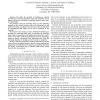Free Online Productivity Tools
i2Speak
i2Symbol
i2OCR
iTex2Img
iWeb2Print
iWeb2Shot
i2Type
iPdf2Split
iPdf2Merge
i2Bopomofo
i2Arabic
i2Style
i2Image
i2PDF
iLatex2Rtf
Sci2ools
GLOBECOM
2006
IEEE
2006
IEEE
Toposemantic Network Clustering
— We study the problem of building an optimal network-layer clustering hierarchy, where the optimality can be defined using three potentially conflicting metrics: state, delay and bandwidth. The problem of network clustering where a node’s addresses depends on the node’s location (e.g. in the hierarchy) is well studied. We study a problem where network nodes are addressed by specifications that might not be tied to locations in the topology. We propose and compare several distributed clustering algorithms: (i) clustering based solely on topology, (ii) clustering based solely on semantics (node specifications) and (iii) a combination of the above methods (toposemantic network clustering), where we specify a parameter that determines how much the clustering depends on topology and how much on semantics. We show that the toposemantic method yields the best results when we know the right parameter value for a given topology and assignment of specifications. We propose an algorit...
Clustering Algorithms | GLOBECOM 2006 | Node’s Location | Optimal Network-layer | Telecommunications |
Related Content
| Added | 11 Jun 2010 |
| Updated | 11 Jun 2010 |
| Type | Conference |
| Year | 2006 |
| Where | GLOBECOM |
| Authors | Leonid B. Poutievski, Kenneth L. Calvert, Jim Griffioen |
Comments (0)

